Finding the correct saddle is an essential first step for any beginner rider.
Saddles are crucial pieces of equipment that help you maintain your balance while riding and protect you and your horse from harm. That’s why you should put money into one that works for both of you.
Throughout the world, English saddles are an essential part of English-style riding competitions. They come in a variety of types that are commonly divided into groups based on how they are built and what they are used for.
The English saddle is one of the most common types of saddles, and it is used for both recreational and competitive riding.
Since an English saddle is likely to be your first horseback riding purchase, I’ll give you a brief overview of the several varieties available
Table of Contents
List of English Saddles
The term “English Saddle” refers to the type of saddle required for English riding, including jumping, dressage, eventing, and many others.
Saddles usually get their names from different styles of riding. These include:
- All-purpose (AP) Saddle or Eventing Saddle
- Dressage Saddle
- Jumping Saddle or Close Contact Saddle
- Endurance Saddle
- The Saddle Seat Saddle
- English Showing Saddle
- Sidesaddle
- Racing Saddle
- Polo Saddle
1. All-purpose (AP) Saddle or Eventing Saddle
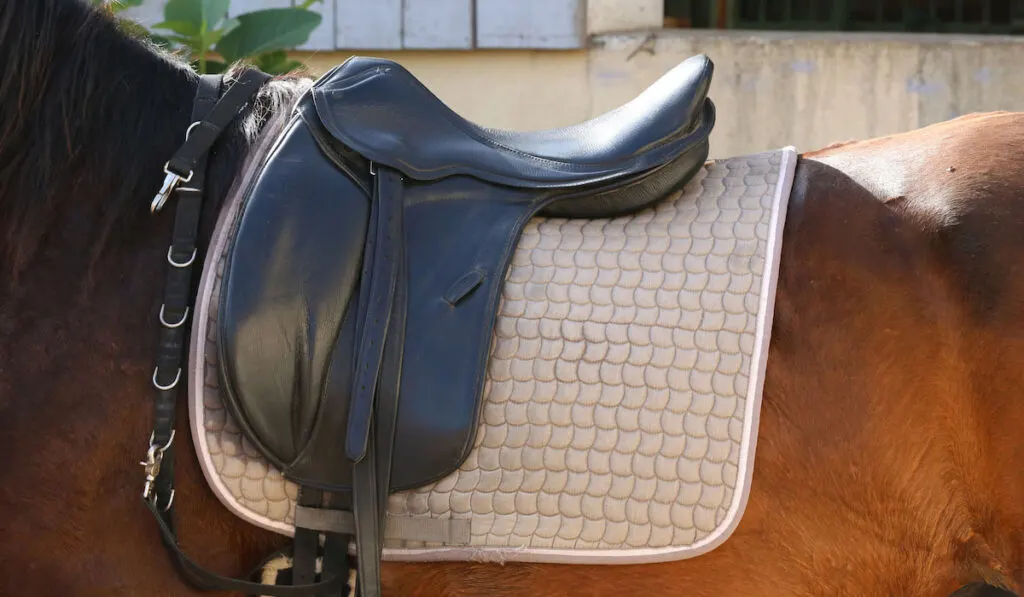
Perhaps you haven’t given much thought to the type of saddle you’d like to purchase. Or, if you’re like me and enjoy dressage but also jump the occasional cross-rail during your sessions, a universal saddle is what you need.
As its name suggests, an all-purpose saddle or an eventing saddle can be used for various types of riding without breaking the bank.
The truth is that riders with varied interests can benefit from using an all-purpose saddle since it is well-suited to a wide range of riding styles.
Its adaptability is a strong attribute, but you should bear in mind that if you’re looking to specialize in a certain style of riding, this saddle might not be enough.
If that’s the case, you’ll need a saddle that is tailored for your specific training, which means all-purpose versatility isn’t what you’re looking for.
AP saddles are rather deep, have relatively long flaps, and point slightly forward.
The goal of the design is to find a middle ground between a deep-seated saddle with a long, straight flap and a flatter, close contact jumping saddle with a flap that goes forward.
The undersides of the flaps are often padded to make the jumper’s legs feel more comfortable and give them more support.
As a result of the padded panels, AP saddles are quite pleasant for both rider and horse.
On the other hand, a good saddle pad is the way to go if you want to maximize the level of comfort provided by your AP saddle.
Because of its deep, comfortable seat, AP saddles are often used for trail riding, endurance riding, and even easy hacking.
Thanks to its longer flaps, flatwork can be done with relative ease, while the high cantle provides extra security.
With a saddle that performs exceptionally well in both trail riding and jumping situations, the horse has more room to jump. The rider is more comfortable too, thanks to the saddle’s deep design and lower pommel.
These multifunctional all-purpose saddles usually target new riders. You’re more likely to see a saddle like this in lower-level junior competitions or among amateur owners.
AP saddles are also recommended for those who are just beginning to train young, feisty horses.
2. Dressage Saddle
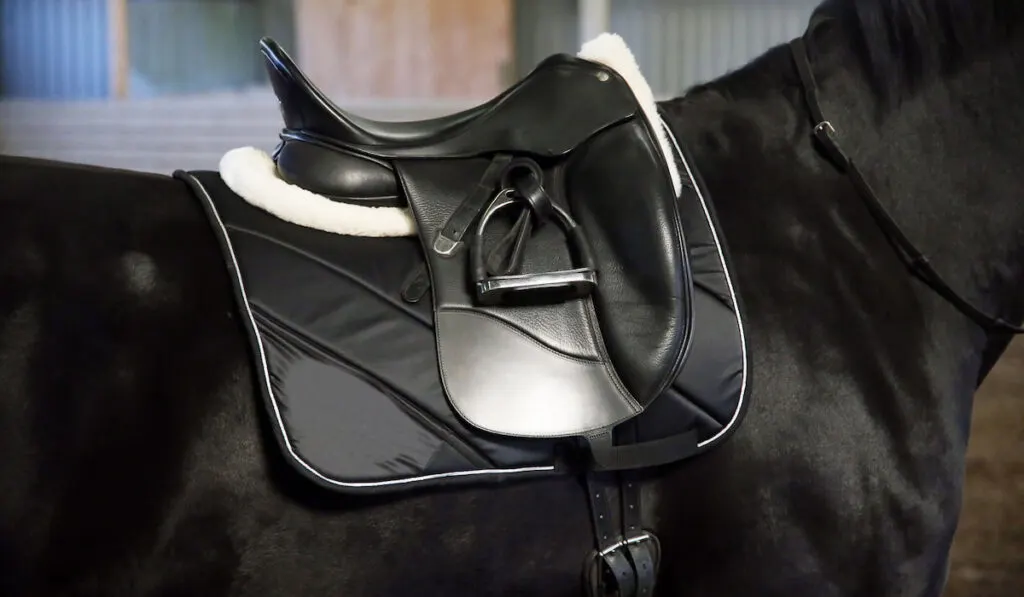
A dressage riding event is where you will find the Dressage saddle commonly used.
During a dressage competition, both rider and horse are scored on how successfully they can perform a sequence of moves.
The horse and rider must be in complete harmony for this sport to be successful. As a result, the horse is able to perform complex moves in response to the rider’s most modest inputs.
A dressage saddle is specially designed to provide the highest level of support for the horse and rider during a dressage competition.
Dressage saddles are distinguished by their deep seats and straight flaps.
The security of this saddle is most evident when the rider jumps. This forward-tilting saddle should keep the rider in place.
For a dressage saddle to work, the cantle needs to be higher, and the flap needs to be straighter.
Dressage riding requires keeping your legs almost straight from the hips down. This moves the rider’s balance point a few inches from the saddle’s pommel.
To help with this, the stirrup bars are set up so that the rider’s legs are further back than they would be in a jump saddle.
Straight flaps aid the rider in keeping their balance and keep them in an extended, connected position with the horse.
The deeper seat lets the rider use their weight to help them get control of the horse.
The best dressage saddles are always getting better at helping the rider use weight aids in a more subtle way. Most come with a variety of flap lengths and different block sizes.
3. Jumping Saddle or Close Contact Saddle
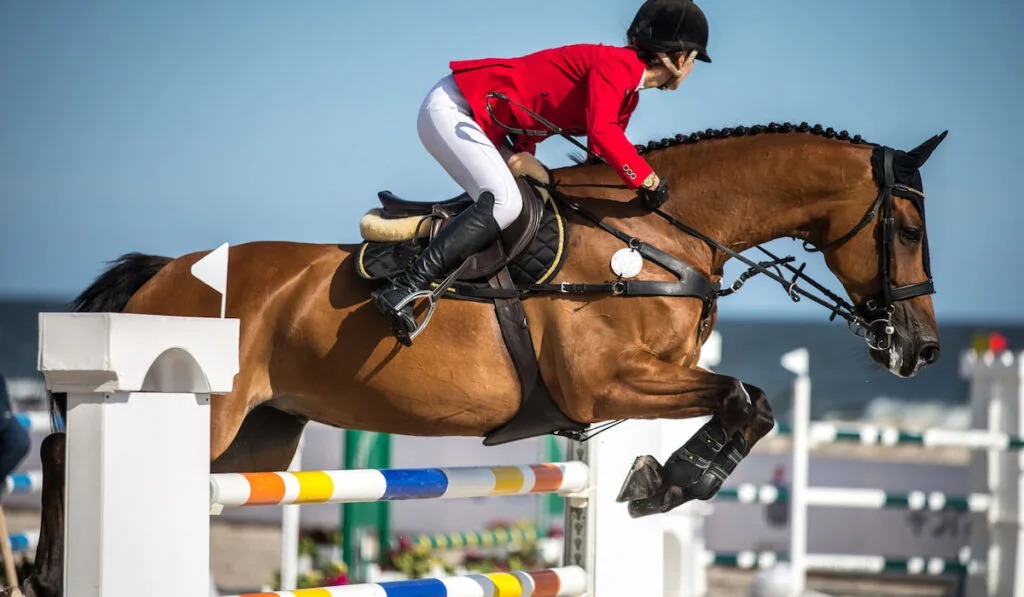
If you’re ready to handle the hurdles, this saddle is exactly what you’ve been looking for!
A jumping saddle, which is sometimes called a “close contact” saddle, is mostly used for show jumping and hunt seat equitation.
When jumping, this saddle is designed to encourage a forward body position as you ride.
Jumping saddles have flat seats and flaps that are cut forward to make room for the rider’s knees. The rider can sit comfortably on this seat with a strong knee and hip bend.
A jumping saddle’s seat is flatter so the rider can take various positions in the saddle, and the flap is cut lower so the rider can use shorter stirrups for greater control when jumping.
With the short length of the stirrups, riders may quickly and easily lift their legs after landing after a jump.
4. Racing Saddle
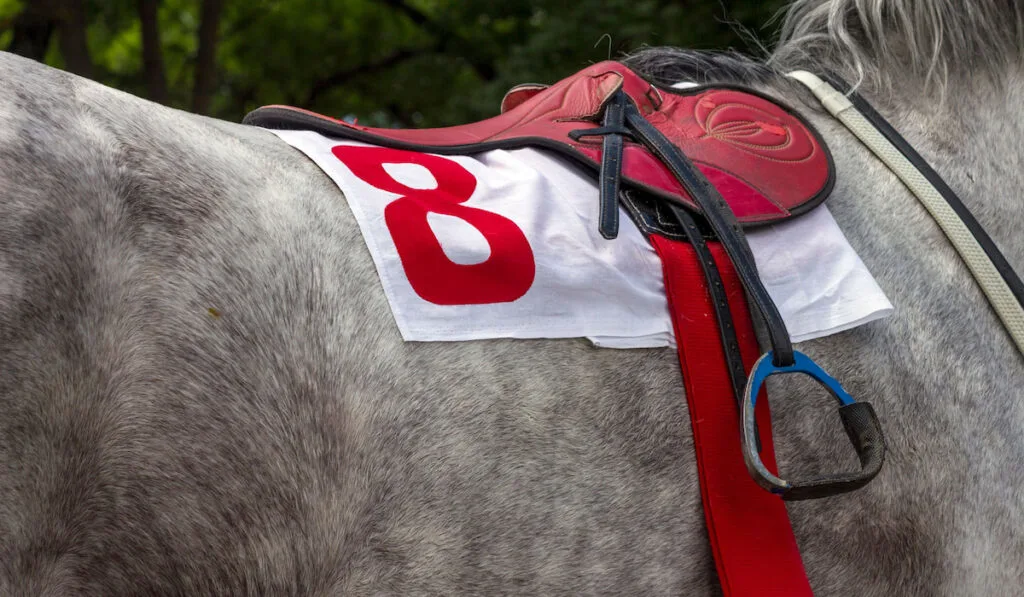
The primary consideration when designing a racing saddle is minimizing interference with the horse’s movement in a way that allows the racing horse to reach its maximum potential in terms of speed.
And the second most important factor is the weight of the racing saddle.
Too much weight on the horse can cause a loss of steam and speed. And as in any professional competition, every gram counts.
The lightest flat racing saddles weigh as little as 8 ounces, and the vast majority of these saddles weigh less than 1.5 pounds.
Saddles used in horse racing are designed with a long seat, no draft, and forward-set flaps to accommodate the jockey.
In addition, the cantle and pommel of a racing saddle are designed to be flat so as not to block the rider in any way.
This saddle doesn’t give the rider much security.
The rider is positioned such that the horse can move as freely as possible, allowing for maximum speed, but this leaves the rider with less control and less protection.
For safety reasons, exercise saddles are typically larger and heavier than saddles used in racing, with a cantle and pommel that are more forward-set.
Due to their design, racing saddles are inappropriate for recreational horseback riding.
5. Endurance Saddles
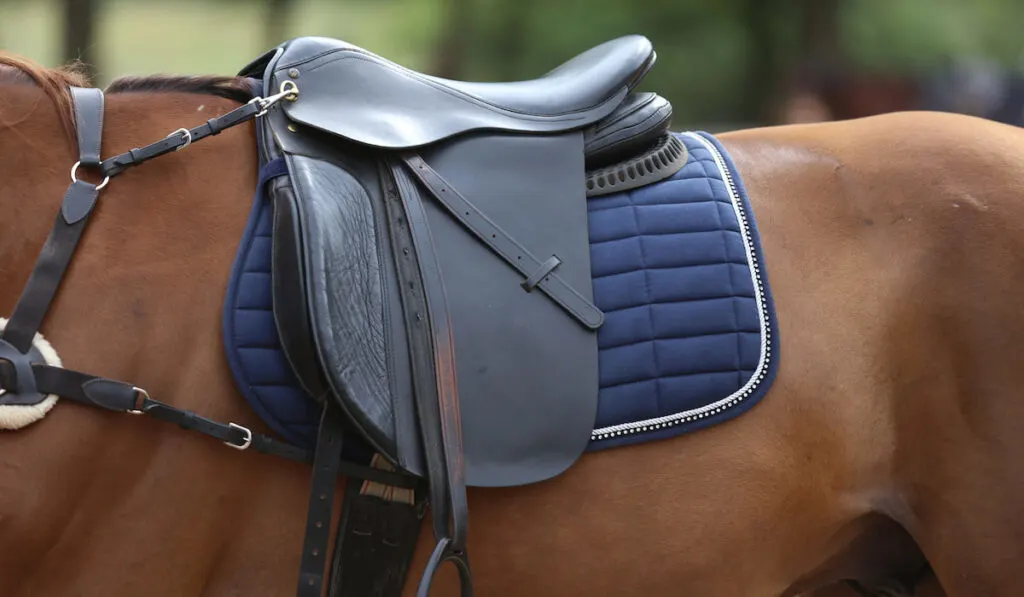
The endurance saddle is intended for long rides, so it has to be lightweight, sturdy, and comfortable.
As its name implies, the endurance saddle is for longer distance competitions, and it is based on saddles used by the military and police.
In order to keep both the rider and the horse safe and comfortable during the course of an endurance ride, appropriate equipment is needed.
Hence, the endurance saddle has earned a reputation as the most comfortable saddle in the UK.
The seat of an endurance saddle is what makes it different in the eyes of the rider. The wide foot tread on the stirrups and the well-padded saddle give comfort during extended rides across different terrains.
For the horse, by increasing the surface area of contact between the saddle and the horse’s back, expanded saddle panels help to alleviate the strain that comes from carrying a heavy load.
To fit the extra gear that endurance riders need to bring, the saddles are designed with a larger number of D-rings surrounding the saddle.
Having an endurance saddle is not necessarily limited to those who participate at the professional level. You should check them out if you need a solution to go great distances on your horse without sacrificing comfort.
6. English Showing Saddle
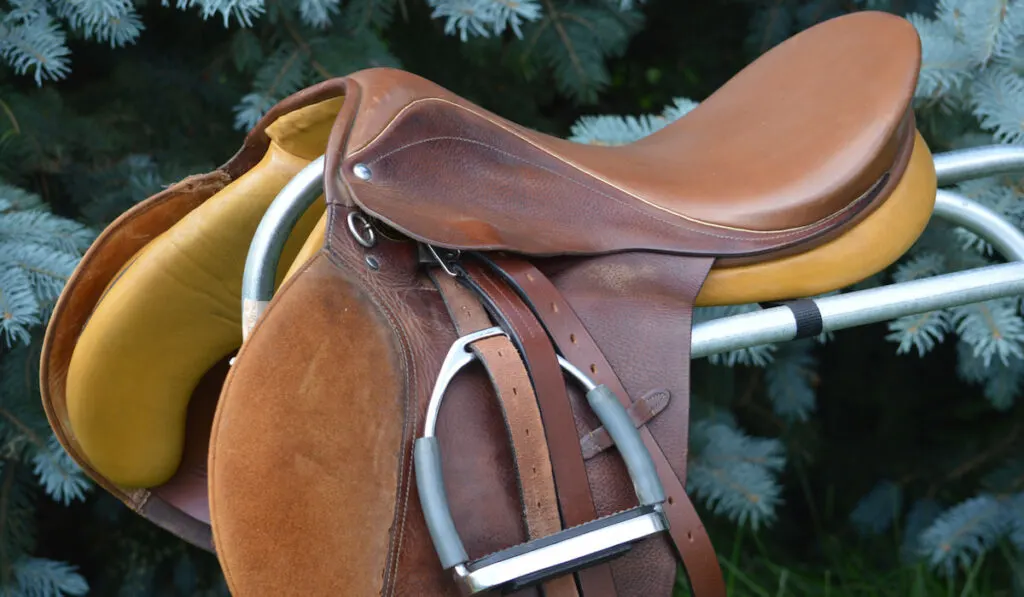
The English showing saddle is a direct descendant of the traditional English hunting saddle. It has become a popular choice for showing on flat ground or low jumps in places like the UK and Australia.
The show saddle is a minimalist piece of equipment with a tight fit and a straight-cut flap to highlight the horse’s conformation (particularly the shoulder).
This saddle provides very little comfort for the rider due to its extremely flat seat and lack of knee and thigh rolls. As compared to the pommel, the stirrup bar is located further forward.
7. Sidesaddle
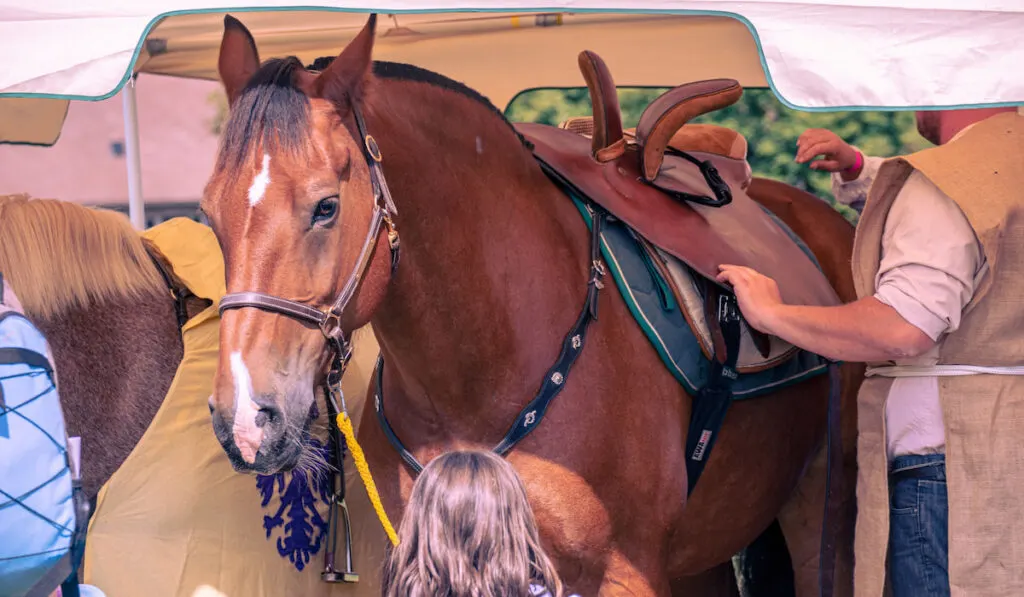
Between the 14th and 19th centuries, ladies rode in a saddle called the side saddle. As it was thought unladylike to straddle a horse and ride like the men, this saddle allowed the ladies to keep their legs to one side.
Some riders still use the side saddle because it is more difficult than conventional styles, which helps the sport stay alive.
Although not as common as it once was, the side saddle is still frequently seen in public displays like parades and shows. Side saddles are even permissible while competing.
Yet, due to their declining popularity, they can be challenging to track down and may cost more than expected.
Sometimes viewed as antiques, these saddles can be found in old barns, stables, or antique shops. They are lovely examples of history and traditional craft, and they offer terrific value to boot.
The sidesaddle is complete with one stirrup, a horn, and two pommels. A sidesaddle without a horn is deemed to be risky.
The rider has plenty of room to sit comfortably on the broad seat.
8. Polo Saddle
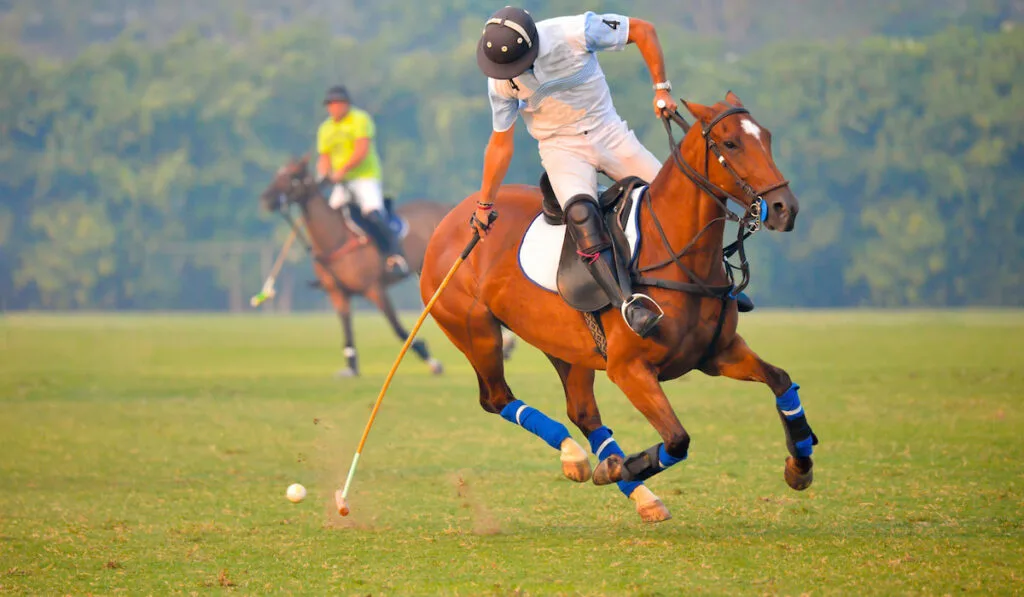
You’re right in assuming that polo saddles are needed to play the sport on horseback.
The difference with polo saddles is that they don’t pad the rider’s leg. This lets the rider’s legs move freely.
For riders to gain points while playing polo, they must be able to move their legs freely while riding. This is the most important factor in the polo saddle design.
Aside from that, these saddles have long, straight flaps that are designed to keep the legs in a straight line so that the rider can maintain their posture.
And polo saddles typically feature a flatter seat than other types of saddles.
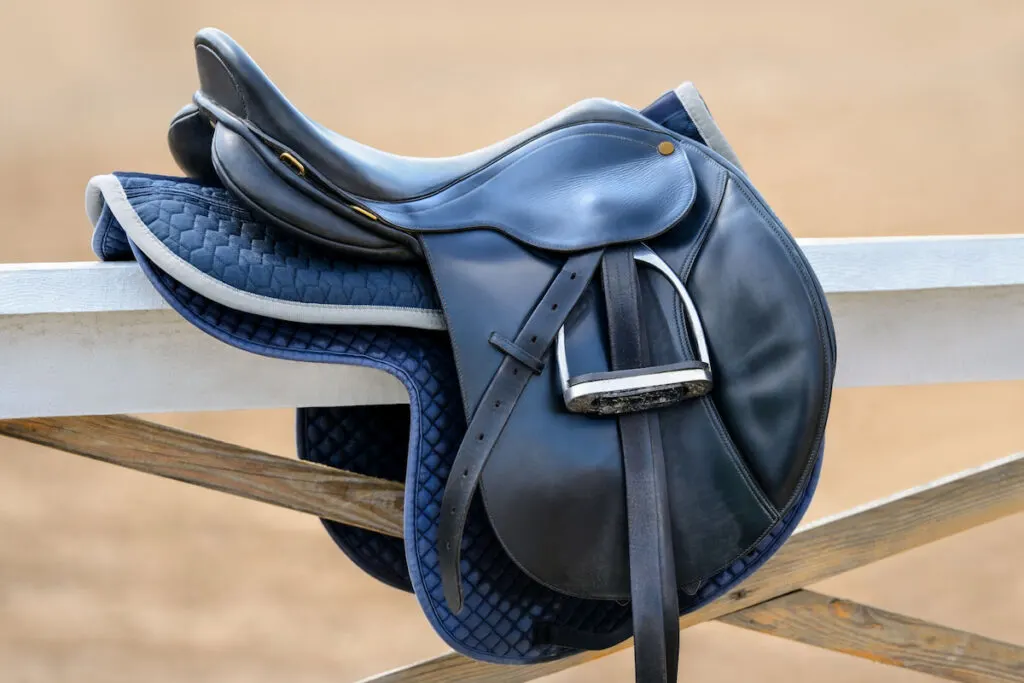
What Are the Top 5 Brands of English Saddles?
These days, you can get a high-quality saddle from various manufacturers.
Nonetheless, if you want the greatest saddle for your horse, then the following brands of English saddles are the best choices:
1. Antarès
- Placement in the top echelon of the market.
- Precision designed for the highest potential.
- Intended for experienced riders.
2. Bates
- Dedicated to providing high-quality comfort.
- Adjustable to a high degree.
3. Collegiate
- Superb value for money.
- Perfect saddle for the beginner rider.
4. Pessoa
- Excellent both on the road and over fences.
- Superior quality product.
- They are distinguished by their feel and balance.
5. Hermès
- Custom-made to fit your exact specifications.
- Very pricey yet of excellent quality.
Final Thoughts
Buying a new saddle is a significant expense for those who like horseback riding. Comfort for you and your horse is just as important as functionality regarding the equipment you use.
While searching for your ideal saddle, an English type is often first considered. Their greatness and market prestige have been established over many years.
It’s important to narrow down your options when shopping for an English saddle, as there are many variations to choose from.
If you wish to compete in a particular discipline or class, you should get the greatest saddle you can afford for that event.
Those who ride more for fun than for the sake of competitions should look for the most comfortable, forgiving saddle they can find.
Always ensure the saddle you choose is a good fit for your horse.
Resources
- https://en.wikipedia.org/wiki/English_saddle
- https://www.lanoirsaddleworld.com.au/product-category/saddles/dressage-saddles/
- https://englishsaddle.com/jumping-saddles/
- https://saddleandbridle.com/articles/diagonals/674-what-is-saddle-seat
- https://horserookie.com/best-english-saddle-brands/
- https://antares-sellier.com/shop/en/custom-saddles/2745-jumping-antares-saddle-contact.html
- https://batessaddles.com/
- https://www.weatherbeeta.com/for-horses/saddles-saddlery
- https://pessoausa.com/contact-us/
- https://www.hermes.cn/cn/en/story/156036-bespoke-equestrian-cn-en/
- https://horserookie.com/best-english-saddle-brands/
- https://horsyplanet.com/types-of-english-saddles/

